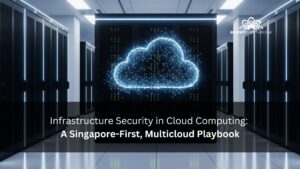Infrastructure as Code (IaC) and Infrastructure as a Service (IaaS) often confuse IT decision-makers in Singapore and Southeast Asia. In essence, IaaS lets you rent compute, storage, and networking, while IaC allows you to automate and manage that infrastructure with code for speed and reliability. This article compares the two in-depth, helps you identify which is best for your scenario, and shares local context, real-world examples, and actionable steps. Let’s explore this together until the end to understand how to best combine IaC and IaaS for modern, resilient cloud infrastructure.
Table of Contents
ToggleTL;DR – Quick-Glance Comparison
| Dimension | Infrastructure as a Service (IaaS) | Infrastructure as Code (IaC) |
| Primary Goal | Rent compute/network/storage on-demand | Automate provisioning & config with code |
| Cost Model | OPEX-heavy pay-as-you-go | Minimal direct cost; drives OPEX down via automation |
| Latency/Regions | Singapore, Jakarta, Kuala Lumpur, Manila | Same as underlying cloud, but deploys to multiple regions in minutes |
| Compliance Touch-points | MAS-TRM, PDPA, IMDA | Adds policy-as-code guardrails to meet the same frameworks |
| Skill Set | Cloud ops, network admin | DevOps, Git, Terraform/Pulumi, YAML/JSON |
| Vendor Lock-in | Moderate—tied to chosen provider | Low-to-medium—tooling can abstract providers |
| Deployment Speed | Minutes (console/API) | Seconds (pipelines) |
| Disaster Recovery | Snapshots, multi-AZ | One-command environment rebuild |
| Observability | Cloud-native dashboards | Code can embed log/metric resources |
| Typical Use | Foundational cloud resources | CI/CD pipelines, immutable infra, reproducible envs |
What IaaS Means for ASEAN Businesses
Since AWS launched its Singapore region, Infrastructure as a Service has become the core model for organizations looking to rent raw compute, storage, and networking without building data centers. Azure, Google Cloud, and Alibaba Cloud now operate in multiple Southeast Asia locations. IaaS benefits include elasticity, regional latency under 10ms, and CAPEX reduction.
For a deeper dive into the advantages of Infrastructure as a Service, we break down cost models, scaling patterns and support tiers. You’ll also find a list of Infrastructure as a Service vendors with their SLAs.
What IaC Brings to the DevOps Table
Infrastructure as Code automates IaaS by expressing environments in code for repeatability and speed. For example, a Terraform snippet can create a new AWS VPC in Singapore instantly:
provider “aws” {
region = “ap-southeast-1”
}
resource “aws_vpc” “main” {
cidr_block = “10.0.0.0/16”
tags = { Name = “sg-production” }
}
IaC reduces manual work, ensures auditability, and enables rapid disaster recovery. Learn more in our dedicated Infrastructure as Code vs IaaS guide.
Extended Head-to-Head: 10 Decision Criteria
- Deployment speed – IaC pipelines slash manual clicks.
- Compliance – Policy-as-code can enforce MAS-TRM controls.
- Costs – Automate spot instances to maximize OPEX efficiency.
- Skills & Team Size – IaC requires DevOps; IaaS can be handled by smaller ops teams.
- Security Posture – IaC templates enforce secure baselines.
- Vendor Lock-in – Multi-provider IaC tools mitigate but don’t eliminate lock-in.
- Latency – Both rely on chosen regions; IaC accelerates failover.
- Disaster Recovery – IaC enables instant environment rebuilds.
- Observability – IaC can auto-provision monitoring and alerting.
- Maturity Curve – IaaS is foundational; IaC is the growth accelerant.
Decision Framework: Which Fits Your Scenario?
- FinTech and Digital Banks – Often require both: IaaS for hosting, IaC for fast, auditable deployments. See Cloud Banking Solutions in Singapore & SEA for compliance insights.
- Growth-stage SaaS – IaC-first for speed and cost optimization.
- Traditional Enterprises – Start with IaaS, layer IaC to replace manual processes.
Case Study: Grab’s Hybrid Playbook
Grab publicly shared its multi-cloud approach leveraging Terraform-driven IaC on AWS and GCP. Their Coban control plane manages over 5,000 data streaming resources with API uptime >99.95%. This hybrid IaaS + IaC approach enables scale and reliability without manual overhead.
Organizations weighing governance can also explore managed vs cloud services to determine when to outsource operations.
Security, Compliance & Cost Control in ASEAN
IaC helps codify MAS-TRM, PDPA, and IMDA requirements, ensuring encryption, logging, and recovery plans are embedded in the infrastructure. Automating life-cycle policies with IaC can reduce cost by leveraging spot and reserved instances.
Our Cloud Security Consulting Services in Southeast Asia provide in-depth support for secure IaC deployment.
Getting Started: Toolchain & Skills Map
- Foundational – YAML, basic CLI, cloud consoles
- Intermediate – Terraform, Pulumi, Git, CI/CD
- Advanced – Policy-as-code, Crossplane, Service Mesh
Consider VMware alternatives for on-prem transitions that integrate seamlessly with IaC strategies.
Bringing It All Together
Infrastructure as a Service gives raw resources; Infrastructure as Code delivers automation, speed, and reliability. The optimal strategy for most Southeast Asian organizations is to combine both.Need a migration roadmap or operational support? Fill this form for a free consultation with an Accrets Cloud Expert. Already cloud-native but need reliability? Explore our Managed IT Services.
Dandy Pradana is an Digital Marketer and tech enthusiast focused on driving digital growth through smart infrastructure and automation. Aligned with Accrets’ mission, he bridges marketing strategy and cloud technology to help businesses scale securely and efficiently.




